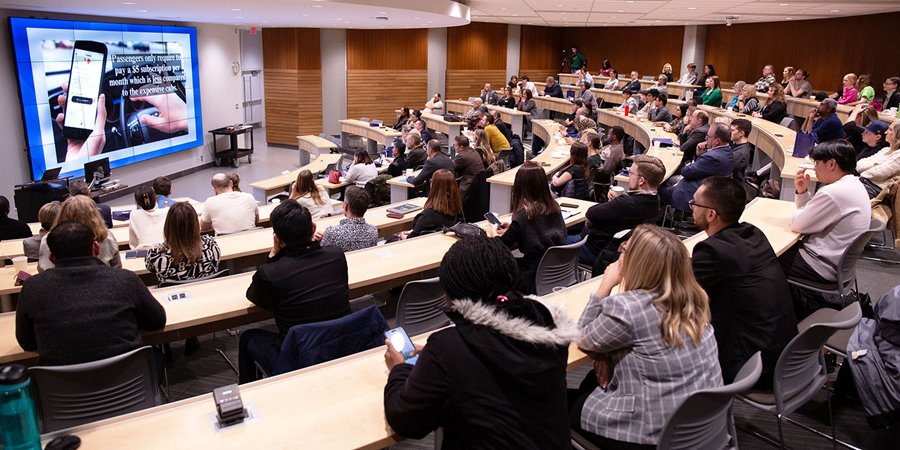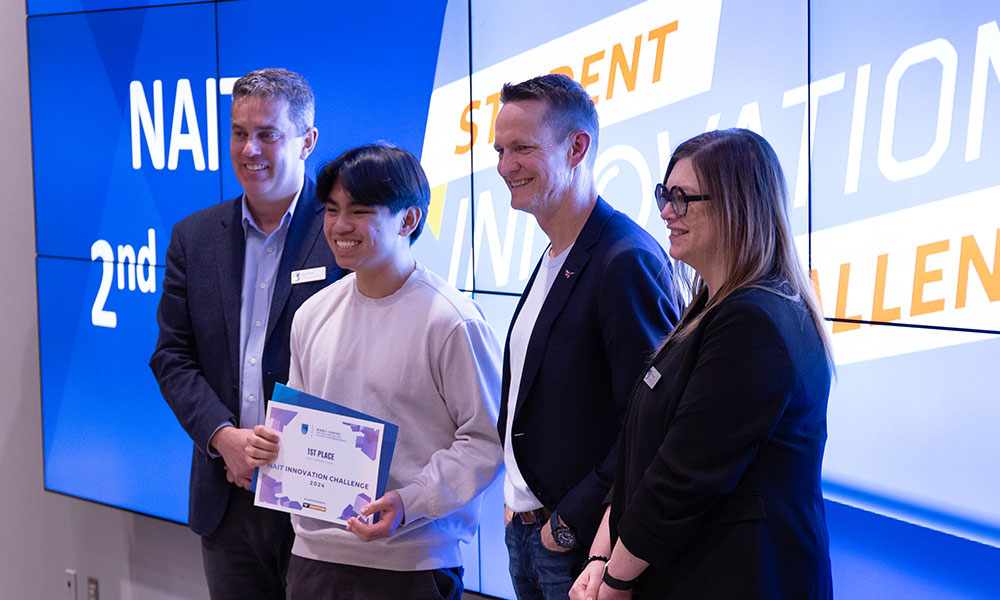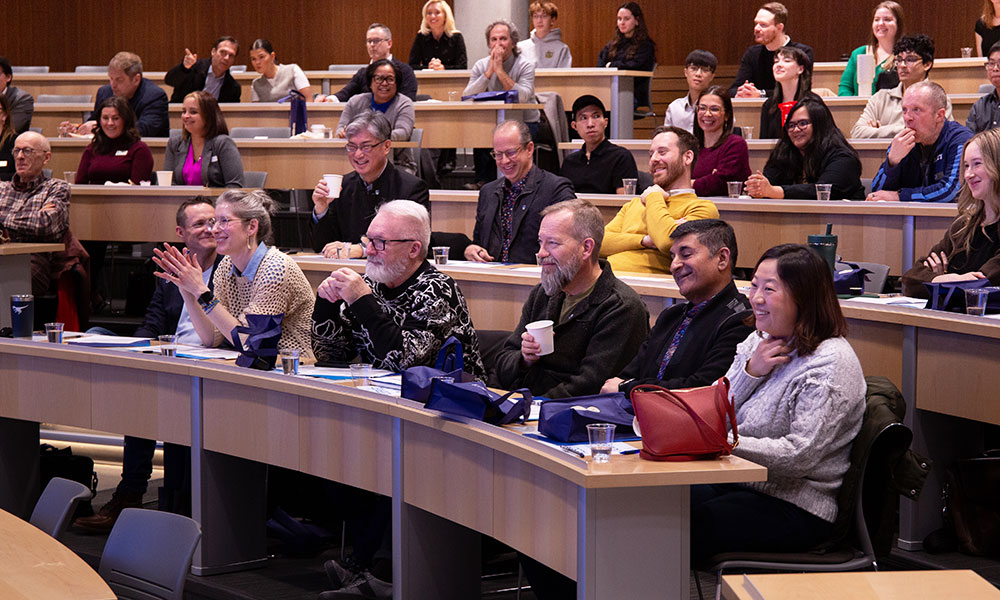Mawji Centre for New Venture and Student Entrepreneurship matches big thinking to big problem
Over the next half-century, the population of Edmonton will likely double – to two million people – without increasing its current footprint. This is not a bad thing: a denser city can lead to a leaner, more efficient one. It can also boost vibrancy. “Dense concentrations of people are one of the necessary conditions for flourishing city diversity,” wrote urban theorist Jane Jacobs.
But the influx will also mean a greater strain on the environment – the focus of the 2024 Innovation Challenge.
Each year since 2017, the Mawji Centre for New Venture and Student Entrepreneurship has invited student groups to come up with creative solutions for problems presented by community partners. Groups comprise students from across the polytechnic’s schools or, more recently, high school students.
This year’s partners included the City of Edmonton, the solutions-generating Capital City Pilots project, and Karhiio Ward Councillor Keren Tang. The challenge: head off the ecological impact of accommodating two million people – and, for good measure, add an entrepreneurial aspect to the solution.
The event, which involves presenting an idea by way of a short video in just a few days, drew its largest number of entries yet, says Mawji Centre manager John Sutherland.

“Overall, we're trying to help students think about the world a little differently and [supplement] their current skill sets with some business acumen – and with some excitement about how they might be able to bring about positive change,” he says.
By the end of the 2024 event, at Main Campus on Feb. 7, three groups of NAIT students shared $3,000 in prizes (covered by sponsor Raptor Mining; the members of the high school team each earned a $250 Visa gift card). More importantly, however, event partners came away with solutions to address pressing issues such as power generation and water and waste management.
"I was quite impressed by the range of creative ideas that the students presented, from behavioral change to environmental regulation to repurposing resources to better support environmental sustainability,” says Tang.
“Challenges like this are so beneficial because they're an opportunity for community leaders and thinkers – with different backgrounds, perspectives, and ways of approaching a question – to gather, connect and together find new ways to solve a problem.
“This is how innovation happens and thrives.”
Here’s a look at how Edmonton, one of Canada’s fastest growing cities, might address the boom to come.
Learn more about how the Mawji Centre helps NAIT students pursue their entrepreneurial ambitions
1st place: Vortex Dynamics
Hunter Dufault, Electrical Engineering Technology
John Nasitem, Computer Engineering Technology
“How do we power a growing city while reducing our reliance on fossil fuels?” ask Nasitem and Dufault. Their answer is hydrokinetic turbines powered by stormwater and runoff.
“We realized there was a lack of utilization of our current storm sewer system other than for its main purpose,” says Nasitem. “This is something that we could expand upon and make better.”
Even if running at just 50% efficiency, a system of turbines could generate 150,000 kWh/year, the team estimates, or enough electricity for about 20 typical Alberta homes.
2nd place: Bio Driveway
Neza Benedicto, Bachelor of Technology
Marie Grabowski (Medical Laboratory Technology ’10, Radio and Television – Radio ’06, Bachelor of Technology
Carri St. Pierre, Bachelor of Technology
More people in the city will mean more pavement – keeping precipitation from getting into the ground where it belongs. Some 6,000 acres of green space are expected to be lost, says the team, leading to pollutants being washed into ecosystems and the potential for flooding.
The permeable Bio Driveway is their solution. Composed of gravel layered with an activated charcoal mat topped with structured peat moss and a grass-clover blend, the eco-friendly pad would filter out contaminants as water passes through. The city would need to amend current regulations to permit the Bio Driveway, says the team.
Until then, “this competition was a great experience for us to learn about more ways to be environmentally influential,” the members write.
3rd place: CompoCity
Karlene Guy, Bachelor of Technology
Angela Ryl, Bachelor of Business Administration
The increase in high-density housing in response to population growth will complicate efforts to compost organic waste. As they decay in a landfill, organics produce methane, a greenhouse gas more than 28 times as potent as CO2. “When you separate those food scraps they can be turned into valuable compost or energy – a win-win for reducing emissions,” says Guy.
Their solution, CompoCity, a company that provides reusable bags for organic waste that would be exchanged weekly by staff for clean, empty bags. The concept would reduce waste destined for the landfill, create jobs and generate income. The team estimates that high-quality CompoCity compost could sell for up to $4,000 per tonne.
Yearly revenue could reach $5.5 million per year as Edmonton grows.
High school winner: Thrive Edmonton
Argyll Centre school
Traditional sprawling suburbs won’t be a sustainable solution for accommodating Edmonton’s growing population. Instead, students at Argyll Centre school propose Thrive – affordable, factory-built, net-zero homes small enough to be inserted into everything from vacant lots to strip mall conversions.
What comes next?

Will storm drain turbines, permeable driveways, compost services and factory-built infill define Edmonton’s higher-density future? Perhaps not as shown, if at all. But that isn’t exactly the point of the Innovation Challenge, says Sutherland. Instead, it’s to foster an environment that will lead to even more ideas in the future.
“[The event] helps us create a vibrant community so that different types of students get to meet and understand a little bit about what each other does and skill sets that they bring to the table,” says Sutherland.
It’s meant to bring together business, technology and trades, he adds, in a way that students will encounter in their careers. And, if those students don’t go on to become entrepreneurs, it prepares them to put imaginative problem-solving to work for companies that hire them.
In the meantime, though, the Innovation Challenge remains a source of fresh thinking for its community partners – and maybe of hope when issues to be addressed can be measured in millions.
“It's invaluable to have students engaged in finding new ways to tackle this big challenge and share innovative solutions that can improve how we continue to grow as a city,” says Tang.
“Seeing the talent we have here in Edmonton that will help to shape our future is inspiring.”
Meet the judges

Judges for the 2024 Innovation Challenge include influential members of the community and local entrepreneurs.
“If any of these [ideas] were something that could come to market, these are some of the people who could … make it happen,” says John Sutherland, manager of the Mawji Centre for New Venture and Student Entrepreneurship.
- Ali Carson, Economic Development Specialist, City of Edmonton
- Abbie Stein-MacLean, Head, Capital City Pilots
- Keren Tang, Councillor, City of Edmonton
- Paul Weber, President, Raptor Mining (which sponsors the Innovation Challenge)
- Mawji Centre Advisory Council members:
- Lyle Best, Chairman, Quickcard Group of Companies
- Craig Harder, Founder and CEO, Raptor Mining
- Chris Izquierdo, CEO, Sparrow Connected
- Sam Jenkins, Managing Partner, Punchcard Systems; CEO and Co-founder, Standard Field Systems
- Blaine LaBonte, President, DJI Capital
- Hubert Lau (Honorary Degree '23, Computer Systems Technology ’91), President and CEO, TrustBIX; JR Shaw School of Business Entrepreneur in Residence
- Ashif Mawji (Computer Science Technology ’92), serial entrepreneur; founder of the Mawji Centre
- Mike Schoenberger (Telecommunication Engineering Technology '90), CEO, Sunco Communication and Installation
Banner image by benedek/istockphoto.com